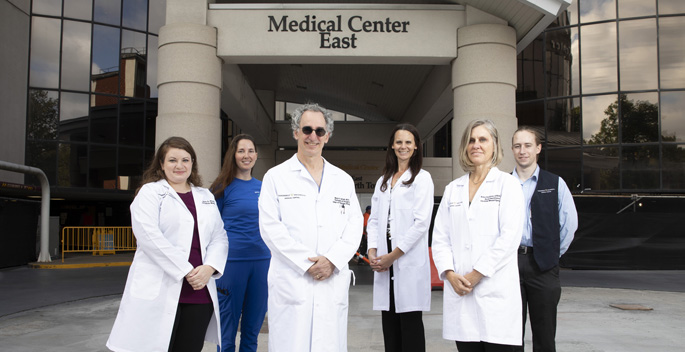
by Jill Clendening
Chronic wounds impact the quality of life for an estimated 2.5% of the United States population, and because successful treatment of poorly healing wounds often requires intervention by specialists in several medical fields, Vanderbilt University Medical Center has established the comprehensive, multidisciplinary Vanderbilt Wound Center.
The center, whose clinicians began seeing their first patients in August, treats adults with slow-to-heal wounds not responding to conventional care. These individuals now see wound care specialists in one location with well-coordinated treatment to better promote healing.
The Vanderbilt Wound Center is directed by Mark Iafrati, MD, professor of Surgery, who joined the VUMC faculty in July. Iafrati most recently served as director of the Tufts Center for Vascular, Wound Care and Hyperbaric Medicine, as well as program director of the Vascular Surgery Fellowship and director of Vascular Surgery Research at Tufts Medical Center in Boston. He served as chief of Vascular Surgery at Tufts from 2006 until 2020.
During its first month of operation, based solely on word-of-mouth referrals, the Vanderbilt Wound Center had 45 outpatient visits. By September, that number had grown to 135 visits, and that volume is expected to continue to increase.
“We’re so fortunate to have recruited Mark to lead our new Vanderbilt Wound Center,” said Seth Karp, MD, H. William Scott Jr. Professor and chair of the Section of Surgical Sciences. “He brings unique qualifications and great expertise, both as a top clinician specializing in vascular surgical techniques to support healing, and as an organizational leader in this specialty. The convenience for patients is enormous as the new clinic offers specialists working collaboratively in one centralized space to provide optimal wound care. Already, we’re seeing great progress under Mark’s leadership.”
The Wound Center is located in Suite 3300 on the third floor of Medical Center East, with plans for relocation to a larger, permanent location on the Medical Center campus in 2022.
“Chronic and acute wounds can quickly become debilitating, especially when multisystem, chronic diseases are working under the surface to disrupt healing,” Iafrati said. “There is a growing, troubling prevalence and incidence of nonhealing wounds, particularly as our population continues to age and live longer with chronic disease. Individuals with wounds that just don’t heal often become incredibly frustrated as they struggle with even basic daily tasks.
“We have the specialized skills, technology and collaborative culture here to expertly address the complex needs of these patients. The cross-specialty collaboration we’ve achieved just a few months into opening the Wound Center is truly remarkable, and I look forward to continuing to expand our services,” Iafrati said.
A wound is a disruption of the normal structure and function of the skin and underlying tissue. When individuals have one or more underlying medical conditions, chronic, nonhealing wounds and ulcers can occur. The body’s ability to repair itself also diminishes with age, so the elderly can easily develop chronic wounds. The most common nonhealing wounds affecting the lower extremities are associated with chronic venous insufficiency, peripheral artery disease and diabetes.
Conditions treated at the Vanderbilt Wound Center include, but are not limited to:
- Calciphylaxis (ulcers due to calcium buildup in tissues).
- Diabetic foot wounds.
- Failed skin/muscle flaps.
- Gangrene.
- Necrotic wounds.
- Osteomyelitis (bone infection).
- Pressure wounds.
- Pyroderma gangrenosum (causes large ulcers, often on legs).
- Radiation injury/wounds.
- Spider bite wounds.
- Surgical wounds.
- Venous leg ulcers.
During an individual’s initial visit to the Vanderbilt Wound Center, a thorough evaluation is completed to identify factors that might contribute to poor healing. If necessary, diagnostic labs are performed. An individualized treatment plan is developed, and patients are educated about at-home wound care. Wounds are measured and monitored during follow-up appointments to judge the response to treatment, and the patient’s referring or primary care physician is kept informed of the treatment plan.
Specialists from several fields make up and are being added to the Vanderbilt Wound Center team including vascular surgery, podiatry, infectious diseases, plastic surgery, trauma surgery, general surgery, nutritional science, physical medicine and rehabilitation, and advance practice nursing. Treatment can include nutritional counseling and support, medications, and specialized therapeutic dressings and devices.
Advanced surgical interventions might also be recommended, including debridement, skin grafting, flaps, vein ablation, open and endovascular revascularization, and amputations as needed. Support with orthotics and various off-loading techniques to reduce pressure on a wound is also available. When the center moves to its permanent location, hyperbaric oxygen (HBO) therapy, a key adjunctive therapy, will be added.
The Wound Center will participate in clinical trials to offer qualifying patients access to promising new therapies. Clinical trials of advanced biologic products for refractory venous and diabetic ulcers, as well as surgical implantation of a prosthetic vein valve for patients with deep venous disease will be among the first trials to begin enrollment.
“We are assembling the best and brightest in order to tackle impaired healing from every possible angle,” Iafrati said. “And we take particular care to identify and address correctable causes of poor healing to reduce the likelihood of future wounds. Examples of addressable issues might be poorly managed diabetes, poor circulation or sensation, foot issues and areas of excessive pressure on the body. Our hope is that patients will come to us for help in healing, and then return to a greatly improved quality of life, with less anxiety about another troublesome wound.”
Patients can be referred to the Vanderbilt Wound Center by calling 615-421-1274.












